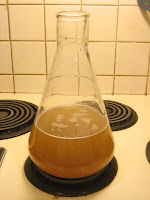I decided to brew another Belgian ale or two. I'll shoot for roughly the same AVB as the last, between 5% and 6% abv. John Palmer's suggested 1/2 cup DME per pint should be fine. I might add just a little more since my specific gravity will be higher than 1.040. Again I'm assuming that keeping the original gravity of the starter and the wort will help. (who am I to argue with all these people who write books about the stuff)
I gathered the equipment, boiled up a starter wort, pitched the yeast and set it aside for three or four days. I'd like to get it brewed before the weekend if possible. Here are the details.
(reusing White Labs Belgian Ale Yeast WLP550)

Grabbed my equipment. Didn't really need all this. Here's what I used; 2000 ml, stopper, airlock, yeast, Beer Brite, lighter, growler, bowl, paper towels, carboy brush, small funnel. The flask isn't really necessary, but, makes it easier to boil a starter because you can boil the starter wort in the same thing you will ferment in.

I use B-Brite for cleaning and sanitation. One tablespoon per gallon of warm water.

Added 1/2 a tablespoon of B-Brite to this growler and filled it with warm water.

Shook the growler a few times, cleaned the cap and poured the B-Brite cleanser into this bowl. I'll use this solution any time I need to clean equipment.

Getting ready to remove the stopper from the yeast slurry in this flask. I saved if from the bottom of primary fermenter two months ago when I brewed those two Belgian style ales. Since then it has been refrigerated in my beer fridge in the basement.

Removed stopper and airlock. Placed it in the cleaning solution while I prepare to transfer the slurry into the growler. If I had another flask I wouldn't need to do this, but, I don't. Note to self store slurry in growler next time.

Before I pour the slurry into the growler I want to sanitize the lip of the flask. It's been sitting around in fridge for two months. Could have bacteria on it. I use a lighter to do this.

Slosh the slurry around to get it all into solution. That way little chunks won't plug up the funnel when I transfer it.

The flask is dirty and I need to clean the stuff from the sides using a carboy brush.

Boiling one quart of water. I should probably use one pint like John Palmer suggests, but, I figure the bigger the better. If anybody knows a reason not to this, let me know.
Next time I'll mix the dry malt extract in ahead of time. Then boil. Much easier.
one cup DME
one quart water

Transferring the slurry to the growler. The funnel has been soaking in the cleaning solution for a while now and should be sanitized. The growler should also be sanitized by now.

Shook up the slurry to aerate. I'm thinking that will help later when I pitch it into the

Flask after struggling to get the DME into the flask and almost boiling it over. Again next time I'll mix the DME into the water first, then boil it ;-)
Boiled for about fifteen minutes to sanitize.

Added the sanitized stopper and airlock. Cooling off the wort in a pan of water. Still makes me nervous. I'm afraid the glass will shatter due to temperature differences, but, I'm not willing to wait. Need to do some more research.
Note: I sanitized the lip of the flask with a flame again.

Once the temperature falls to the right temp pitch the slurry into the wort. You're shooting for a pitching temperature around 75 degrees after both solutions are mixed. I'll leave the rest up to you.
I'll brew in three or four days.
No comments:
Post a Comment